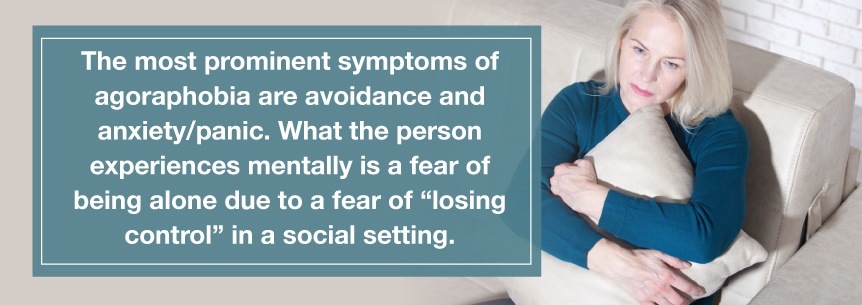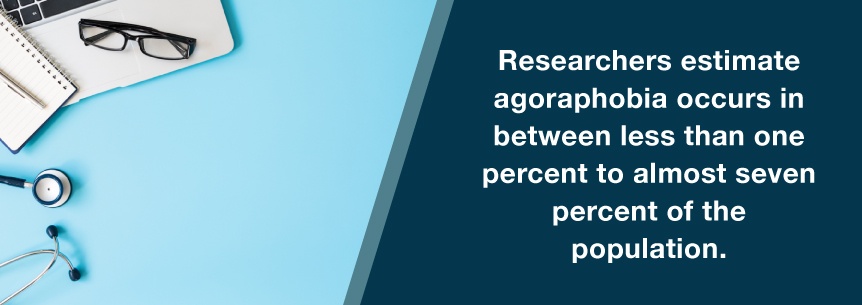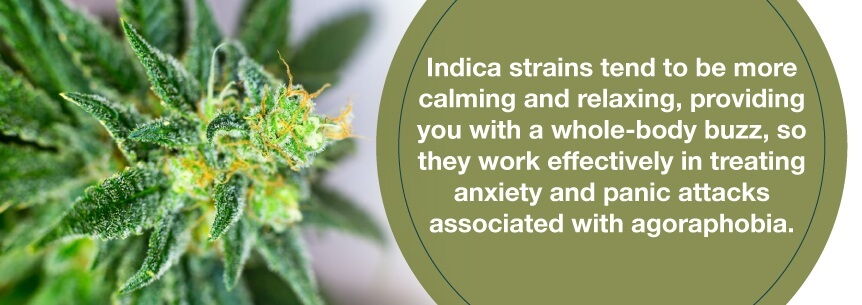Whether you’ve been struggling with agoraphobia and its related anxiety and panic attacks for years, or you’ve recently received a diagnosis, you know the symptoms can make leaving your home difficult. While prescription medications are often one of the methods doctors use to treat agoraphobia, researchers are finding that medical cannabis can complement prescription drugs or work as a natural alternative to them — and medical marijuana for agoraphobia shows a lot of promise.
Agoraphobia is an anxiety condition where you fear and avoid situations or places that could make you feel trapped, embarrassed or helpless or cause you to panic. You fear both anticipated and actual situations or places like:
To be diagnosed with agoraphobia, you need to have intense anxiety or fear of two agoraphobic situations, such as those listed above. You also need to display avoidance behaviors relating to those situations.
Around 0.9 percent of adults in the U.S. have agoraphobia, according to the National Institute of Mental Health (NIMH). Nearly 41 percent of agoraphobia cases are thought to be severe. Agoraphobia can be extremely disabling in more severe cases.
Many individuals who develop agoraphobia get it after they’ve had one or more panic attacks. This causes them to avoid the places where an attack happened because they’re worried about having another.
If you have the condition, you likely find it difficult to feel safe when you’re in a public place, particularly where it gets crowded. You might feel you can’t go to public places without having someone with you, like a friend or relative. The fear may overwhelm you so much that you feel you can’t leave your home.
The reasons behind agoraphobia remain unclear, but it’s believed there are areas in your brain that control your response to fear, and this might play a role.
Other contributors can be environmental factors, such as being the victim of a physical attack or abuse. Genetic factors could also play a role since anxiety disorders can be hereditary. Agoraphobia also seems to occur more often in people with different physical ailments like asthma or irritable bowel syndrome (IBS).
The most prominent symptoms of agoraphobia are avoidance and anxiety/panic. What the person experiences mentally is a fear of being alone due to a fear of “losing control” in a social setting. This dependence on other people for moral support stems from a hope the person can save them from these situations should panic arise. They also have a fear of places they may not be able to leave on short notice, such as planes, buses, and trains. These feelings can result in panic. Panic attack symptoms include sweating, difficulty breathing, dizziness, fainting, hysteria, pain, tingling and nausea/vomiting.

Some symptoms of agoraphobia include fears of:
In some instances, you may fear you won’t be able to get help if you begin feeling panicked or experience other embarrassing or disabling symptoms, and this causes your anxiety. Your anxiety or fear usually results from the exposure to the situation.
Other signs of agoraphobia include:
Any phobia will likely cause you to avoid whatever makes you scared. For instance, some individuals with arachnophobia, just looking at a photo of a spider can cause them phobia symptoms.
One of the primary coping mechanisms of agoraphobia is avoidance. To ensure they don’t feel panic, the sufferer avoids a situation where panic may arise or where panic is deemed unacceptable. To escape the negative consequences of such behavior, an agoraphobia sufferer may internalize his or her thoughts or feelings, again, leading to a worsening of symptoms. These coping mechanisms may work to relieve symptoms of anxiety or cut them off before they begin at the moment, but they reinforce the overall disorder.
Those with severe agoraphobia may find life even more challenging than someone with a mild case. For example, an individual with severe agoraphobia can become a hermit since they won’t leave their house, even for a routine task such as shopping. It doesn’t matter what your phobia is. If it’s left untreated, it can potentially impact your quality of life.
In the Diagnostic and Statistical Manual of Mental Disorders (DSM) used by psychologists, psychiatrists, and other mental health professionals, there are currently two types of agoraphobia listed. These are:
You can have agoraphobia and not experience panic attacks. You might experience anxiety or feelings of fear, but they don’t progress into a full-blown panic attack. Today, agoraphobia is classified with its own diagnostic code and is separate from panic disorders.
When you have agoraphobia, it increases your chances of developing another anxiety disorder such as:
Agoraphobia also predisposes you to have more difficult and severe anxiety disorders. Those with agoraphobia have a higher risk of abusing drugs or alcohol as well.
Individuals who go through panic attacks might change how they function or behave in the workplace, at school or at home. They might try avoiding situations that might potentially trigger another panic attack, and they might become depressed.
In a study with 60 patients that had a panic disorder or agoraphobia, researchers were trying to determine the occurrence and severity of depressive and anxiety symptoms.
Of these patients, 68 percent (41 patients) had a current or past major depressive episodes, and 85 percent (35 patients) suffered from endogenous-type major depression. Thirty-three percent (20 patients) had a primary major depressive episode. Twenty-eight patients had major secondary depression, and patients who already had a history of significant depression suffered from a more serious anxiety disorder.
When left untreated, agoraphobia can get to the point that it substantially impacts your life, or the act of trying to hide or avoid situations has a severe impact on your life. In fact, some individuals with the condition failed in school, had problems with loved ones or lost their jobs while they were trying to deal with it.
Facts associated with agoraphobia according to the National Institute of Mental Health (NIMH), include:
MedicineNet.com reports:

In 1871, Carl Friedrich Otto Westphal, a German psychiatrist, introduced the term, describing his observations of people living with panic sensations when challenged with the thought of being in public. Charles Darwin was one of the earliest noteworthy people known to have agoraphobia.
While numerous treatment options exist for agoraphobia, treating it may be challenging since it requires you to face your fears. However, medications and psychotherapy, along with cannabis, can help you tackle agoraphobia and live a more peaceful and less intimidating life.
Your doctor will likely recommend a combination of treatment options, which include:
A few forms of therapy include:
Medications help by altering the way the patient’s mind reacts to anxiety-producing stimuli. They can have both negative and positive effects on sufferers.
Numerous medications can help relieve your symptoms of agoraphobia or panic attacks. These include:
Selective Serotonin Reuptake Inhibitors (SSRIs)
These might include fluoxetine (Prozac) or paroxetine (Paxil). Side effects of SSRIs may include:
Selective Serotonin and Norepinephrine Reuptake Inhibitors (SNRIs)
These include duloxetine (Cymbalta) or venlafaxine (Effexor). Side effects of SNRIs may include:
SNRIs could also cause serotonin syndrome (rare) where you have dangerously high serotonin levels.
Tricyclic Antidepressants
These include nortriptyline (Pamelor) or amitriptyline (Elavil). Side effects may include:
Anti-Anxiety Medications
These may include clonazepam (Klonopin) or alprazolam (Xanax). Side effects may include:
Although making some lifestyle changes aren’t going to treat the condition itself necessarily, it can help lower the anxiety caused by agoraphobia. Some lifestyle changes you can implement into your daily routine are:

Avoid taking anti-anxiety dietary herbs and supplements during treatment since it’s not proven they reduce anxiety and could interfere with your prescription medication effectiveness. The one exception to this is cannabis for agoraphobia.
There is some evidence medical marijuana can help anxiety disorders and phobias, of which agoraphobia is both. While there are numerous anxiety medications like SSRIs and sedatives, many patients seek more natural and fast-acting alternatives with fewer adverse side effects. For many of these patients, cannabis and agoraphobia treatment is their solution. Science is exploring the claims of the compounds in medical weed working at a cellular level to reduce anxiety when dosed correctly.
Studies have shown that CBD acts as an anxiety-reducing drug or anxiolytic and regulates the defensive behaviors threatening stimuli evokes when directly injected into rats’ periaqueductal gray matter (PAG). CBD’s effect in the PAG also helps lower aversion to stressful situations, and it’s panic-reducing (panicolytic) as well.
One Brazil study researchers conducted showed a substantial reduction in the participants’ anxiety after they took CBD. Scientists took scans of some of their brains to validate their subjective reports. The scans showed cerebral blood circulation patterns indicating an anti-anxiety effect.
There is also some evidence medical marijuana can exacerbate symptoms of anxiety. Therefore, you should undertake treatment with the supervision of a medical professional.
Lower THC levels and higher CBD levels of cannabis seem to work best and help:
These levels are also safe and highly effective.
It’s known marijuana can affect mood as well. In fact, the human body produces similar substances to the active substances in marijuana called “endocannabinoids.” Various parts of your body have receptors for these molecules.
Like anxiety medications, medical marijuana can have both negative and positive effects. Some people may feel a decrease in anxiety-related symptoms. Others will feel an increase. Nonetheless, marijuana has the upper hand in that it cannot result in a deadly overdose, whereas many narcotic anxiety medications can result in deadly overdoses.
There is a lot to be said for thought patterns and control when it comes to agoraphobia. Negative, catastrophic thought patterns contribute to sensations of anxiety. Perceived lack of control over those symptoms can also contribute to panic and anxiety. In cases where medical marijuana has a positive influence over a sufferer’s symptoms, the patient can experience the medicine as control over the symptoms. Knowing it can help and is available can, in and of itself, relieve the symptoms in the same way that being in an area thought of as safe to the sufferer relieves fear and panic.
There’s limited knowledge about how marijuana can help some people with anxiety disorders and not others. However, it is quite clear marijuana alters the mood of the person taking it. There is some evidence the strain of marijuana smoked or ingested plays a role in the effect. The dosage will partially dictate the effect as well. Positive effects include relaxation, elation, and reversal of thinking from negative to positive. Possible negative effects include paranoia, heightened anxiety and fear. The effects typically pass when the medical marijuana leaves the system.
Indica strains tend to be more calming and relaxing, providing you with a whole-body buzz, so they work effectively in treating anxiety and panic attacks associated with agoraphobia. In fact, medical marijuana and agoraphobia treatment may reduce anxiety and panic significantly when used in low quantities. The CBD in medical pot is abundant in many indica strains.

When you are deciding on which strains are best for your symptoms of agoraphobia, choose strains with a higher CBD-to-THC ratio, since THC can induce anxiety effects, and the CBD will counteract these effects. Some good marijuana and agoraphobia strains include:
Some medical cannabis for agoraphobia delivery methods makes regulating dosage much easier than others. Vaporizing and tinctures, for instance, provide with you faster anxiety relief and also help you control the dose. Edibles provide longer-lasting effects, but it does take a little longer for the effects to kick in.
Some individuals claim cannabis oil helps regulate their response to stressors, thereby reducing their anxiety, but not impacting their relationships or work. Because of this, many individuals prefer the long-lasting effect and discreetness of cannabis oil.
Physicians don’t usually recommend smoking marijuana, particularly for people with respiratory conditions or lung disorders.
If you’re looking for more information on treating yourself with marijuana for agoraphobia, use MarijuanaDoctors.com to search for a cannabis-certified doctor. Your doctor will also help you choose the right marijuana products and method of consumption for your individual needs.
Additionally, you’ll have the ability to search through our comprehensive list of marijuana dispensaries. Book your appointment today.
Find A Doctor Find A Dispensary
For more information about how cannabis can be used to treat agoraphobia, check out our resources: